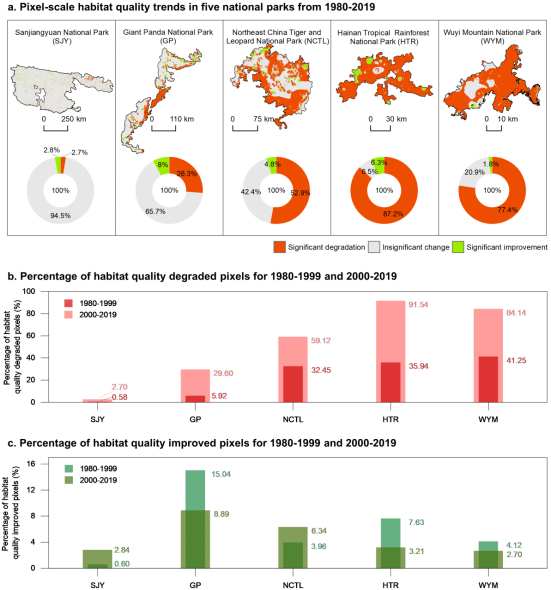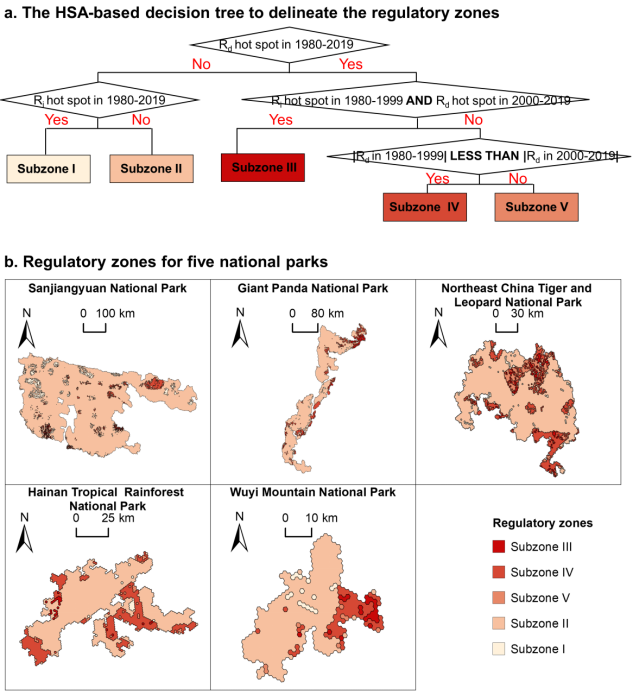National parks are the part with the most important natural ecological system, the most unique natural landscape, the most essential natural heritages, and the greatest biodiversity in China. China’s national park project has shifted from pilot to construction phase with the official establishment of its first group of national parks (CFGNPs) in October 2021. The CFGNPs include five national parks, namely, Sanjiangyuan National Park (SJY), Giant Panda National Park (GP), Northeast China Tiger and Leopard National Park (NCTL), Hainan Tropical Rainforest National Park (HTR), and Wuyi Mountain National Park (WYM). Currently, specific understanding is still missing in such problems as the effect of the past ecological conservation practices in these national parks and which regions in the national parks call for key efforts of rehabilitation in the future.
Yu Le’s Research Group of DESS, Tsinghua University, using the InVEST Habitat Quality (HQ) model, combined with a land use and land cover product and a hot spot analysis (HSA) method, conducted long time-series observations of used to investigate the HQ dynamics at the park- and pixel-scale within the CFGNP in the recent four decades and around the time of the proposal of the United Nations' millennium development goals (MDGs), and put forward the HSA-based regulatory zoning scheme of HQ optimization for national parks in the future. The related research has been recently published as a paper titled "Habitat quality dynamics in China's first group of national parks in recent four decades: Evidence from land use and land cover changes” in Journal of Environmental Management.

Fig. 1. Location of China’s first group of national parks.
According to the national park scale analysis (Fig. 2), the HQ of SJY was relatively stable from 1980 to 1999, and dropped sharply from 2000 to 2005. After that, with the implementation of a large number of ecological rehabilitation projects, its HQ was obviously improved. The HQ of the area where the GP National Park is located, did not change significantly in 1980-1999, but decreased significantly in 2000-2019. The HQ in the NCTL and WYM areas has been declining in general, and the difference is that the degradation rate of the HQ in the WYM area is accelerating, while that of the HQ in the NCTL National Park is slowing down. The HQ in the area where HTR National Park is located increased in the first two decades, but decreased significantly in the last decade. Pixel-scale analysis shows (Figure 3) that the HQ in more than half of the areas where HTR, Wuyishan and NCTL National Parks are located significantly degraded from 1980 to 2019. In addition, the stage comparison shows that the proportion of HQ-degraded area in the areas where the five national parks are located has increased.

Fig. 2. Temporal trends in mean habitat quality of the CFGNPs

Fig. 3. Pixel-scale habitat quality trends in the CFGNPs from 1980–2019.
Hot spot analysis (HSA) shows that HQ degradation hot spots often occur in areas with relatively dense human activities near urban residential areas or the edge of national parks. For example, two HQ degradation hotspots were found in the GP National Park, one near Chengdu and the other in the northeast of the Baishuijiang area. Meanwhile, this study has also found a series of hot spots for HQ improvement, and in recent years, the HQ of some national parks is relatively stable, which reflects that the construction of national parks with higher protection level is expected to reverse the degradation trend of HQ. In view of this, the study finally puts forward the regulatory zoning scheme of HQ optimization of national parks in the future (Fig. 4).

Fig. 4. The regulatory zoning scheme for HQ optimization of the CFGNPs in the future
The shortcomings of this research include: The parameterization of the InVEST habitat quality model mostly depends on expert knowledge and previous researches and the evaluation results are largely determined by the classification accuracy of LULC products. Besides, the InVEST model takes HQ as an indicator for biodiversity, but does not consider species data, and therefore, species with unique requirements for habitats cannot receive sufficient protection by using this model alone. Therefore, future work should include species distribution data for comprehensive evaluation.
Chen Xin, a postdoctoral fellow of the DESS, Tsinghua University, is the first author of the paper, and his co-supervisor Associate Professor Yu Le is the paper's corresponding author. The co-authors of the paper are from the Institute for National Parks, the Department of Landscape Architecture of the School of Architecture, the School of Environment of Tsinghua University as well as other research teams. The research is supported by the National Key R&D Program, the National Natural Science Foundation of China, the Postdoctoral Science Foundation of China and the Independent Scientific Research Program of Tsinghua University.
Full-text link of the paper: https://www.sciencedirect.com/science/article/pii/S0301479722020783
Written by Chen Xin